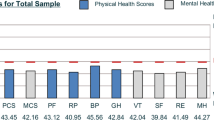Abstract
The Disability and Impact Profile (DIP) is used for the measurement of quality of life in multiple sclerosis (MS) patients. Data from 211 persons with definite MS from Belgium, Denmark and the Netherlands were used to address three questions. To what extent do the impairment ratings and their complementary weighted scores share common variance? What is the factor structure of the weighted scores? To what extent do disease-related information and information from psychological questionnaires offer concurrent validity for the factors? Correlations between impairment ratings and the weighted item scores were high; for most items the complementary ratings of impact do not supplement information provided by impairment ratings. The DIP weighted scores can be represented to some extent by three independent dimensions: a motor (skeletal movement) or displacement ability factor, a factor relating to sensory–cognitive intactness and a psychological well-being factor. A two-factor solution provides a first factor identical to that of the three-factor solution and a second factor representing psychological well-being. The two factors correlate well with instruments measuring disability and with satisfaction versus emotional distress. Provisional scales based on the factors were constructed.
Similar content being viewed by others
References
Laman H, Lankhorst GJ. Subjective weighting of disability: an approach to quality of life assessment in rehabilitation. Disabil Rehabil 1994; 16: 198–204.
World Health Organization. International Classification of Impairments, Disabilities and Handicaps. Geneva: World Health Organization, 1980.
Lankhorst GJ, Jelles F, Smits RC et al. Quality of life in multiple sclerosis: the disability and impact profile (DIP). J Neurol 1996; 243: 469–474.
Pfennings LEMA, Cohen L, van der Ploeg HM. Assessing the quality of life in patients with multiple sclerosis. In: Thompson AJ, Polman CH, Hohlfeld R, eds. Multiple Sclerosis: Clinical Challenges and Controversies. London: Martin Dunitz, 1997: 295–311.
Kurtzke J. Rating neurological impairment in multiple sclerosis: an Expanded Disability Status Scale (EDSS). Neurology 1983; 33: 1445–1452.
Vleugels L, Pfennings LEMA, Pouwer F. Psychological functioning in primary progressive versus secondary progressive multiple sclerosis. Br J Med Psychol 1998; 71: 99–106.
Jønsson A, Dock J, Ravnborg MH. Quality of life as a measure of rehabilitation outcome in patients with multiple sclerosis. Acta Neurol Scand 1996; 93: 229–235.
Pfennings LEMA, Cohen L, Lankhorst GI, Polman CH, van der Ploeg HM. Use of the SF-36 and Disability and Impact Profile in multiple sclerosis patients (abstract). Qual Life Res 1997; 6: 697–698.
Arrindell WA, Ettema JHM. SCL-90.Handleiding bij een Multidimensionele Psychopathologie-indicator (SCL-90.Manual for a multi-dimensional psychopathology indicator). Lisse, The Netherlands: Swets &; Zeitlinger, 1986.
Ploeg HM van der, Defares PB, Spielberger CD. Handleiding bij de Zelfbeoordelings Vragenlijst (ZBV) (Manual for the Dutch Adaptation of the STAI-Y). Lisse, The Netherlands: Swets &; Zeitlinger, 1980.
Spielberger CD. Manual for the State Trait Anxiety Inventory, Form Y. Palo Alto, CA: Consulting Psychologists Press, 1983.
Buijk CA. Manual General Handicap Attitude Scale. Amsterdam: LTP, 1986.
Sarason IG, Levine HM, Basham RB, Sarason BR. Assessing social support: the Social Support Questionnaire. J Pers Soc Psychol 1983; 44: 127–139.
Beck AT, Ward CH, Mendelson M, Mock J, Erbaugh J. An inventory for measuring depression. Arch Gen Psychiatr 1961; 4: 561–71.
Kendall PC, Hollon SD, Beck AT, Hammen CL, Ingram RE. Issues and recommendations regarding use of the Beck Depression Inventory. Cognit Ther Res 1987; 11: 289–299.
Beck AT, Weissman A, Lester D, Trexler L. The measurement of pessimism: the Hopelessness Scale. J Consult Clin Psychol 1974; 42: 861–865.
Bentler PM. EQS: Structural Equations Program Manual. Los Angeles: BMDP Statistical Software, 1989.
Floyd FJ, Widaman KF. Factor analysis in the development and refinement of clinical assessment instruments. Psychol Assess 1995; 7: 286–299.
Lublin FD, Reingold SC. Defining the clinical course of MS: results of an international survey. Neurology 1996; 46: 907–911.
Gonsette RE, Lissoir F, Theys P, Ketalaer P, Droissart C, Demonty L. The natural history of MS in Belgium: an MS clinic-based study. In Firnhaber W, Lauer K, eds. MS in Europe.Epidemiological Update. Darmstadt: Leuchtturm Verlag/TLV Press, 1994: 122–129.
Comi GC, Filippi M, Martinelli V et al. Brain MRI correlates of cognitive impairment in primary and secondary progressive MS. J Neurol Sci 1995; 132: 222–227.
Author information
Authors and Affiliations
Rights and permissions
About this article
Cite this article
Cohen, L., Pouwer, F., Pfennings, L.E. et al. Factor structure of the Disability and Impact Profile in patients with multiple sclerosis. Qual Life Res 8, 141–150 (1999). https://doi.org/10.1023/A:1026481029191
Issue Date:
DOI: https://doi.org/10.1023/A:1026481029191




